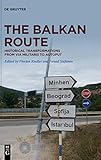The Balkan Route : Historical Transformations from Via Militaris to Autoput / ed. by Florian Riedler, Nenad Stefanov.
Material type: TextPublisher: Berlin ; Boston : De Gruyter, [2021]Copyright date: ©2021Description: 1 online resource (X, 241 p.)Content type:
TextPublisher: Berlin ; Boston : De Gruyter, [2021]Copyright date: ©2021Description: 1 online resource (X, 241 p.)Content type: - 9783110616828
- 9783110617061
- 9783110618563
- 949.6
- online - DeGruyter
- Issued also in print.
| Item type | Current library | Call number | URL | Status | Notes | Barcode | |
|---|---|---|---|---|---|---|---|
 eBook
eBook
|
Biblioteca "Angelicum" Pont. Univ. S.Tommaso d'Aquino Nuvola online | online - DeGruyter (Browse shelf(Opens below)) | Online access | Not for loan (Accesso limitato) | Accesso per gli utenti autorizzati / Access for authorized users | (dgr)9783110618563 |
Frontmatter -- Acknowledgements -- Table of Contents -- Bordering and Mobility as an Approach to the History of the Balkan Route -- The Via Militaris in Transition: From Late Rome to the Crusades -- Continuity of Travel and Transport Infrastructures from Antiquity to the Middle Ages: The Case of Via Militaris in the Morava and Nišava Regions -- Transforming the Landscape of the Constantinople Road in the Fifteenth and Sixteenth Centuries (Section Niš–Dragoman) -- The Istanbul–Belgrade Route in the Ottoman Empire: Continuity and Discontinuity of an Imperial Mobility Space -- Cities along the Route: Plovdiv Becoming “Modern” at the End of the Nineteenth Century -- Tsaribrod, a Dot on the Line: A Microhistorical Approach to Societal Change along the Route in the Nineteenth and Twentieth Centuries -- Park ve Restoran: About Oblivion, Obstinate Mobility and Temporary Infrastructures on the Road -- Voices of the Via Egnatia: Deliberating Migratory Pull-Factors along the Roman Road in the Western Balkans -- Balkan Transit: Conclusion and Outlook -- List of Contributors -- Index
restricted access online access with authorization star
http://purl.org/coar/access_right/c_16ec
This volume approaches the topic of mobility in Southeast Europe by offering the first detailed historical study of the land route connecting Istanbul with Belgrade. After this route that diagonally crosses Southeast Europe had been established in Roman times, it was as important for the Byzantines as the Ottomans to rule their Balkan territories. In the nineteenth century, the road was upgraded to a railroad and, most recently, to a motorway. The contributions in this volume focus on the period from the Middle Ages to the present day. They explore the various transformations of the route as well as its transformative role for the cities and regions along its course. This not only concerns the political function of the route to project the power of the successive empires. Also the historical actors such as merchants, travelling diplomats, Turkish guest workers or Middle Eastern refugees together with the various social, economic and cultural effects of their mobility are in the focus of attention. The overall aim is to gain a deeper understanding of Southeast Europe by foregrounding historical continuities and disruptions from a long-term perspective and by bringing into dialogue different national and regional approaches.
Issued also in print.
Mode of access: Internet via World Wide Web.
In English.
Description based on online resource; title from PDF title page (publisher's Web site, viewed 01. Dez 2022)


